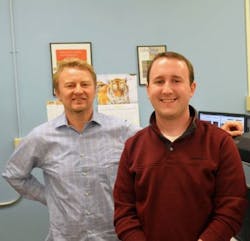Flow cytometry shows how zinc plays vital role in animal, human fertility
Researchers at the University of Missouri (UM; Columbia, MO) used flow cytometry to discover that zinc plays a key role in promoting fertility in males. The findings have implications for improved in vitro fertilization (IVF) and artificial insemination in livestock, as well as for human infertility diagnostics and therapies.
Related: Fluorescent-coated optical fiber sensor could monitor IVF noninvasively
“We have known that giving males zinc supplements—whether pigs or humans—improves fertility," says Peter Sutovsky, a professor of animal science in MU's College of Agriculture, Food and Natural Resources. "Now we know that analyzing zinc signatures can help us quickly evaluate the fertilizing potential and quality of sperm."
Sutovsky and doctoral student Karl Kerns used the flow cytometer, which can take images of up to 2000 cells per second and track biomarkers such as zinc with fluorescent dyes, to monitor zinc localization during various stages of capacitation (the physiological process sperm must undergo to become capable of fertilizing an egg cell) in sperm cells. They found that zinc ions (Zn2+) exert significant control over capacitation beyond merely enabling the process, in that the ion can prevent and even reverse the capacitation process in some cases. This also occurs when an egg has already been fertilized and must defend against another fertilization.
Another product of the research was the ability to quickly and accurately evaluate the fertility of livestock or humans by analyzing their sperm cells with the flow cytometer. This allows for more informed decision-making when it comes to alternative processes such as IVF and artificial insemination. For example, sperm cells are traditionally diluted before artificial insemination into livestock, which eliminates some of the zinc. Preserving the zinc would lead to healthier sperm and a greater ability to identify infertility.
"Infertility is a costly issue for both humans and animals," Kerns says. "This study gives us tools to approach the problem more efficiently by demonstrating the importance of zinc—both as a mediator of fertility and as an indicator we can use to identify issues with sperm. If we could add just one more pig to every litter, that would increase the income of U.S. pork farmers by $130 million per year."
Full details of the work appear in the journal Nature Communications.
